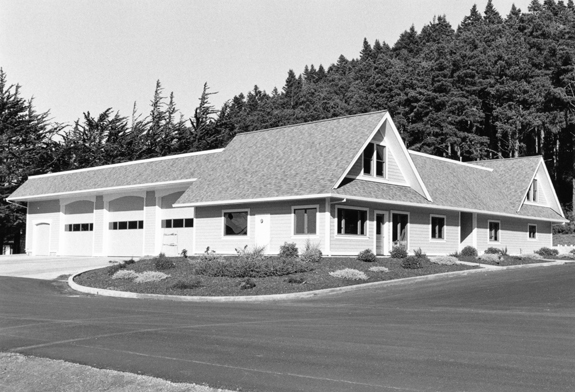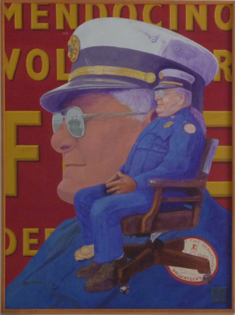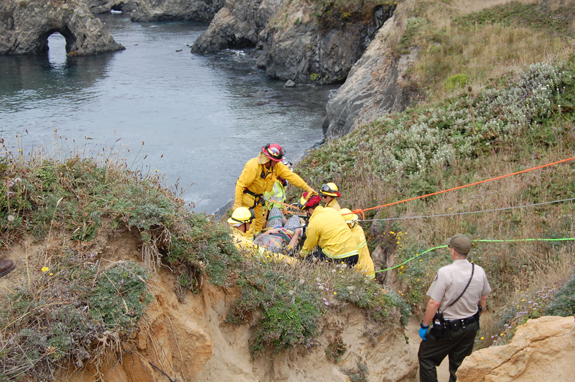MENDOCINO volunteer
FIRE DEPARTMENT
II: The Fire Department’s Modern Era
In its one hundred-twenty-fifth year, the Mendocino Volunteer Fire Department remains all volunteer. Nevertheless, it has grown into a modern department. The Department achieved this with a modern facility and equipment, expanded membership, and extensive training, all with the participation and support of the community.
The most visible sign of the Department’s entry into its modern era was the construction of the new fire station at 44700 Little Lake Road in the 1990s. By this time, the Department had outgrown the firehouse on Lansing Street. Fitting the fire trucks in the old station was a time-consuming puzzle. To park the trucks, their side view mirrors had to be folded in, and their doors could not be opened once inside. Firefighters had to climb in and out of the trucks through the windows.

The location selected for the new station was Joshua Grindle Park, located on Little Lake Road south of the Hills Ranch subdivision. This had been the site of Mello’s Auto Court, and a park that hosted town celebrations and annual fire department barbeques. The park’s trustees had deeded the property to the fire district in 1971.
The new fire station was an ambitious project, a 10,000-square-foot, two-story structure with an office, shop, storage area, meeting room, kitchen, and a drive-through garage designed for six trucks. But as in years past, the community met the challenge. A citizens’ committee helped raise $350,000, in addition to $150,000 the firefighters had already raised themselves. The lead contractor was Assistant Chief Dennis Heyden. He donated his time, as did attorney Jim Larson, architect Paul Douglas, and engineer Lee Welty.
 Firefighters and residents volunteered most of the labor for construction. Construction began in 1992, and the exterior of the building was completed by August 1994. The new firehouse, known as Station 840, was formally dedicated to Chief Foggy Gomes on Sunday, August 27, 1995.
Firefighters and residents volunteered most of the labor for construction. Construction began in 1992, and the exterior of the building was completed by August 1994. The new firehouse, known as Station 840, was formally dedicated to Chief Foggy Gomes on Sunday, August 27, 1995.
At right, this portrait of Foggy Gomes, by artist Matt Leach, was presented at the dedication of Station 840, and still hangs in the garage.
Station 840 now houses the extensive array of equipment necessary to provide fire and emergency services to the community. But equipment is useless without personnel, and with the new firehouse came new members and leaders. Most significantly, women began joining the department. The Department’s first female member was Deborah Casey, who joined in 1999. Teacher Beth Ryan joined the following year, and went on to become the Department’s first female officer. As of 2012, six women serve on the Department, with Captain Sally Swan following in Beth Ryan’s footsteps as an officer.
At the end of 1997, after fifty-three years of service, Eugene “Foggy” Gomes retired as chief. Long-time members stepped up to fill his shoes. First came Steve Schlafer, who served as chief for eight years. Next came Danny Hervilla. In addition to his leadership abilities, Chief Hervilla stood out because of his broad range of skills.
Chief Hervilla’s diverse skills reflected the modern Department’s expanded mission: not just firefighting, but emergency medical care, water rescue, cliff rescue, and vehicle extrication. The expanded mission requires not just extensive equipment, but extensive training on the part of the Department’s volunteer members.

Technically challenging rescues are now part of the skill set of MVFD thanks to the forward thinking of Chief DannyHervilla.
Medical calls make up the vast majority of the Department’s calls. To serve this need, many Department members have completed the demanding and time-consuming college-level course necessary to become an emergency medical technician. Currently, nearly half of the Department’s 34 members are EMTs. In addition, two members are registered nurses, and another a paramedic.
Training has been emphasized under Chief Dave Latoof, who took over leadership of the Department in 2011. In addition to trainings held at most weekly meetings, monthly trainings are held that focus on water rescue, cliff rescue, engineering, and structure fire entry teams. Many members also attend the fire academy, which requires a several-month commitment. Others receive advanced training in engineering.
44700 Little Lake Road • P.O. Box 901 • Mendocino, CA 95460
Phone: 707-937-0131 • Fax: 707-937-4138 • email: mvfd@mcn.org